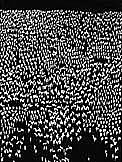Louis le Brocquy Táin illustrations facts for kids

The Táin, 1969. First edition.
|
|
| Author | Thomas Kinsella. Translated from the Irish epic Táin Bó Cúailnge, the central tale in the Ulster Cycle. |
|---|---|
| Cover artist | Louis le Brocquy (slipcase with papered boards). Illustrated throughout with 133 black and white lithographic brush drawings. |
| Country | Ireland |
| Language | English |
| Genre | Irish Mythology |
| Publisher | Dolmen Editions IX, Dolmen Press, Dublin |
|
Publication date
|
1969 |
| ISBN | 978-0-19-280373-3 |
| OCLC | 59500985 |
| 891.6/231 22 | |
| LC Class | PB1397.T3 E513 1970 |
The Tain illustrations are a famous series of drawings by Irish artist Louis le Brocquy. They were created for a special edition of Táin Bó Cúailnge, an ancient Irish epic story. This book, published in 1969, brought the old legend to life with le Brocquy's unique artwork.
In 1967, a publisher named Liam Miller asked Louis le Brocquy to illustrate a new version of the Táin Bó Cúailnge. This version was translated by Thomas Kinsella. The Táin is a very old and important Irish tale. It tells about Ireland's ancient past.
The Táin Bó Cúailnge (which means "The Cattle Raid of Cooley") is a long story. It is the main part of the Ulster Cycle of heroic tales. The story is about King Conchobar mac Nessa and his best warrior, Cúchulainn. Cúchulainn is also known as "The Hound of Ulster." The tale also describes an invasion of Ulster by Queen Medb of Connacht. She wanted to steal the Brown Bull of Cuailgne.
This legend has been around for a long time. It dates back to the 12th century in written form. Many scholars have studied it. Writers like Yeats and Lady Gregory also wrote about it. Thomas Kinsella wanted his version to be "living." He wanted it to truly show the strong and rough nature of the original Gaelic story.
Louis le Brocquy made hundreds of drawings for the book. He worked for six months. He chose 133 of these drawings for the final book. The artist wanted his drawings to feel timeless. He felt they should be "impersonal" and "spontaneous." He saw them as "shadows" cast by the story itself.
Contents
The 1969 Táin Book
The Táin was published in September 1969 by Dolmen Press in Dublin.
Le Brocquy's drawings were highly praised. People loved how well they worked with Kinsella's writing. The illustrations showed le Brocquy as a very original artist. Thomas Kinsella said that le Brocquy had great focus and energy. He believed these qualities made le Brocquy stand out among Irish artists.
Táin Art Collections
Le Brocquy also created special art collections called "Táin Portfolios." These collections had three different sets of twelve black and white drawings. These drawings were chosen from the many Táin illustrations. Each set was a limited edition. Only 70 copies were made. Each drawing was signed, dated, and numbered by the artist. These large drawings were unbound and came in a special box.
The drawings were first shown in Dublin in October 1969. Brian Fallon wrote in The Irish Times that the Kinsella-Le Brocquy Táin book was amazing. He called it a "triumph" for the publisher. He said le Brocquy's art was "epic, stark and primitive." He felt the drawings captured the mythical world of the Táin powerfully.
Different Táin Book Editions
Over the years, several versions of The Táin with le Brocquy's illustrations were published.
- The Táin, Dolmen Edition IX (1969): This was the main limited edition. It had 1,750 copies. It included all 133 black and white drawings.
- The Táin, Deluxe Edition, Dolmen Edition IX (1969): This was a very special version. Only 50 numbered copies were made. The author, artist, and designer signed each copy. It had extra drawings on some pages.
- The Táin, Hardback trade edition (1970): This version was published by Oxford University Press. It included 33 illustrations. These were smaller than the original drawings.
- The Táin, Paperback edition (1972–2007): This was a more common paperback version. It kept 30 illustrations.
- Library Edition (1985): This edition had 108 illustrations. They were slightly reduced in size.
Táin Book Translations
The Táin with le Brocquy's illustrations was also translated into other languages.
- Rinderraub (German, 1976): This German version included 114 full-size illustrations.
- La Razzia (French, 1996): This French paperback edition kept 30 illustrations.
- El Táin (Spanish, 2001): This Spanish version was available in both hardback and paperback. It was fully illustrated.
- 夺牛记 (Chinese, 2008): This Chinese paperback edition included 30 illustrations.

